
copyright © Wartime Heritage Association 2012-2024
Website hosting courtesy of Register.com - a web.com company
Wartime Heritage
ASSOCIATION
Remembering World War II
Name:
Raymond Curtis Balser
Rank:
Staff Sergeant
Service Number:
31117013
Service:
Company C, 1st Battalion,
39th Engineer Combat Regiment, US Army
Awards:
Purple Heart
Date of Birth:
July 14, 1913
Place of Birth:
Grafton, Kings County, Nova Scotia
Date of Enlistment:
June 19, 1942
Place of Enlistment:
Portland, Cumberland County, Maine
Address at Enlistment:
Farmington, Franklyn County, Maine
Age at Enlistment:
28
Height:
5 feet, 10 inches
Occupation:
Farm hand
Marital Status:
Single
Next of Kin:
Frederick N Balser, father
Date of Death:
February 18, 1944
Age:
30
Cemetery:
Sicily-Rome American Cemetery, Italy
Grave:
Section H, Row 9, Grave 4
Raymond Curtis Balser was the son of Frederick Noble Baltzer (1887–1970) and Rebecca Mary (Brewster)
Baltzer (1891–1976). His parents were both born in Kings Co., Nova Scotia as well. His father, in Pereaux and
his mother in Billtown. He had four brothers, Ralph Balser, George, Richard and John; and three sisters Hazel,
Ethel and Arliss. His brother George Alfred also served in the US Army in WWII (Service No. 11016751).
Raymond and his family immigrated to the United States on April 16, 1916, travelling by ferry from Yarmouth,
Nova Scotia to Boston, Massachusetts.
The family lived at Wellesley Avenue in Burlington, Middlesex Co., Mass. prior to 1920 and lived there
throughout the 1930’s and 40’s. In 1937 he worked at the Akeson Fuel Company in Woburn, Mass. In 1940,
Raymond was working as a lumber handler in cabinet making.
Before enlistment in June of 1942, he was living in Farmington in Franklyn County, Maine and working as a
farm hand.
After enlistment, Raymond was assigned to Company C, 1st Battalion,
39th Engineers, which were constituted April 25, 1942, at Camp
Bowie in Texas and redesignated as the 1st Battalion, 39th Combat
Engineer Regiment on August 1, 1942.
Raymond completed his Petition for Naturalization for US citizenship
on June 3, 1943, while serving with the 39th Engineers in Canastel,
Algeria.
Once Sicily was secured in July and August of 1943, mainland Italy
became the next goal with landings in September.
Operation Shingle, landing at Anzio, had become necessary because
the Allied drive up the Italian peninsula had ground to a halt in the
autumn of 1943 some 100 miles south of Rome, in front of a series of
heavily fortified positions that stretched the width of Italy.
After the initial Allied amphibious landings at Anzio on January 22, 1944, Allied forces were still busy
defending their beachhead in February. The 36th and 39th Engineer Combat Regiments, in addition to their
engineer functions, assisted in defending the coastline against airborne and seaborne raids and were to be
prepared to assemble on four hours' notice as Corps reserve.
They were also tasked with improving defenses along the Mussolini canal which ran directly east of Anzio on
the coast and north, inland.
Staff
Sergeant Raymond Curtis Balser was killed in action on February 18, 1944, during the major enemy offensive
from February 16-20 attempting to destroy the Allied beachhead at Anzio.
Raymond was interred at the Sicily-Rome American Cemetery in Nettuno, Italy.
The Sicily-Rome American Cemetery and Memorial in Italy
covers 77 acres, rising in a gentle slope from a broad pool
with an island and cenotaph flanked by groups of Italian
cypress trees. Beyond the pool is the immense field of
headstones of 7,845 of American military war dead,
arranged in gentle arcs on broad green lawns beneath
rows of Roman pines. The majority of these individuals
died in the liberation of Sicily (July 10 to August 17,
1943); in the landings in the Salerno Area (September 9,
1943) and the heavy fighting northward; in the landings at
Anzio Beach and expansion of the beachhead (January 22,
1944 to May 1944); and in air and naval support in the
regions. Sergeant Roderick Morgan MacDougall is one of
these Air Force casualties lost flying air support in the
Mediterranean Theatre.
Raymond is also remembered on a memorial stone at the
Webster Cemetery in Farmington, Franklyn Co., Maine.
Raymond Curtis Balser


Sources
findagrave - Raymond’s Grave
findagrave – Raymond’s memorial stone
American Battle Monuments Commission – Sicily – Rome American Cemetery
Honorstates.org
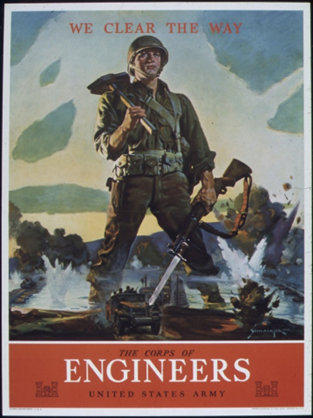
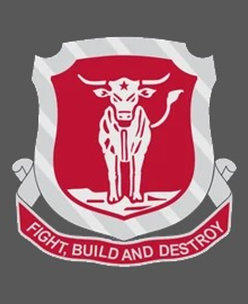
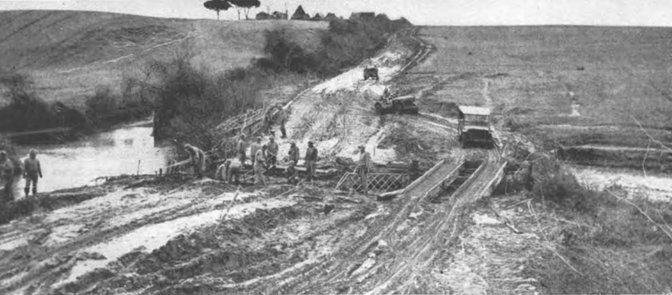
Pictured here, engineers bridge a stream on a road from Nettuno to the front. Frequent rains and enemy shell-fire
damage made this a difficult task, but the roads had to be kept open to move armor against the enemy.
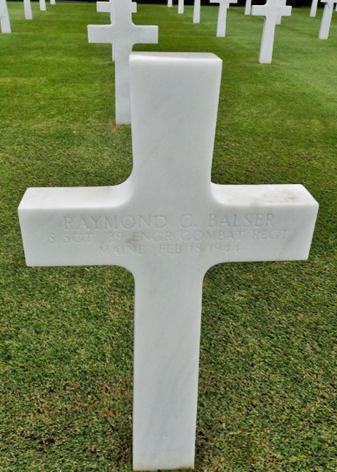
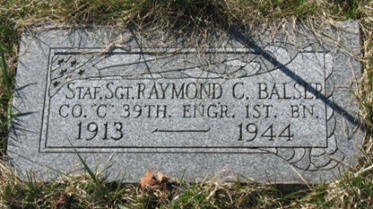


- World War I - Menu
- WWI Stories and Articles
- Photos - Yarmouth Soldiers
- Selection of World War I Songs
- WWI Casualties of Yarmouth, NS
- Those Who Served - Yarmouth, NS
- WWI Casualties Digby Co. NS
- WWI Casualties Shelburne Co. NS
- Merchant Mariners (1915) Yarmouth, NS
- Canadian Forestry Corps - Non Yarmouth Birth/Residence Enlistments
- US Draft Registry - Yarmouth NS Born


- World War II - Menu
- WWII Stories and Articles
- Telegraphist Air Gunners
- WWII Casualties of Nova Scotia
- US Casualties with NS Connection
- Far East/Pacific Casualties with NS Connection
- Merchant Navy Casualties Nova Scotia
- Nova Scotia WWII Casualties Holten Canadian War Cemetery
- D-Day Casualties - Nova Scotia
- CANLOAN Program Casulaties - Nova Scotia
- Battle of the Bulge Casualties - Nova Scotia
- WWII Casualties Yarmouth NS
- Yarmouth Casualties - RCAF RAF Canadian Army WWII
- Yarmouth Co., Marrages WWII
- Casualties Non-Born/Residents with Connection to Yarmouth Co., Nova Scotia.
- WWII Casualties Digby Co., NS
- Non-Nova Scotian WWII Casualties Buried in Nova Scotia
- WWII RCAF Casualties Aged 16-18
- Brothers/Sisters Who Served - World War II













